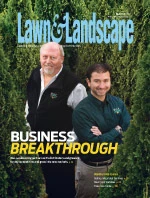 Top Left: A number of trees were brought in to complete the project. Top Right: Contractors brought in their own soil mix to combine with the site's existing soil, which was not conducive to growing many of the new plants used in the project. Bottom: The project called for several small natural trails winding through woody plants, shrubs, specimen trees and a variety of fruits. Photos: dawnscapes; executive plant serviceWhen the owner of a 15-acre estate on Long Islands’s “Gold Coast” wanted to transform a somewhat-barren property into something he could enjoy, it brought together two landscape businesses to do the work. Donald G. Namias, president of Dawnscapes, in East Northport, N.Y., joined forces with an old friend from college, Warren Hertzberg, president of Executive Plant Service.
Top Left: A number of trees were brought in to complete the project. Top Right: Contractors brought in their own soil mix to combine with the site's existing soil, which was not conducive to growing many of the new plants used in the project. Bottom: The project called for several small natural trails winding through woody plants, shrubs, specimen trees and a variety of fruits. Photos: dawnscapes; executive plant serviceWhen the owner of a 15-acre estate on Long Islands’s “Gold Coast” wanted to transform a somewhat-barren property into something he could enjoy, it brought together two landscape businesses to do the work. Donald G. Namias, president of Dawnscapes, in East Northport, N.Y., joined forces with an old friend from college, Warren Hertzberg, president of Executive Plant Service.
The owner of the property wanted to walk his land regularly, but found that most of it was unmanaged and in need of care. Namias and Hertzberg developed the idea of creating a walking trail in an area that already had an existing blackberry and raspberry patch.
“We focused on about an acre and a half of semi-wooded property that we decided to turn into an ‘edible walkway,’” Namias explains. “The project called for several small natural trails winding through woody plants, shrubs, specimen trees and a variety of fruits. We built on the idea of the existing berries by adding some seedless grapes, blueberries, strawberries and several small apple trees.”
A water feature was also added for the homeowner to enjoy during his strolls. It was constructed in a grassy area that had been hit by lightning, clearing away several trees and creating an opening. The bubbling rock water garden uses lava rocks of different heights taken from Mount St. Helens, with water flowing through a recharge basin. The surrounding gravel features tropical seasonal annuals.
In addition to the edible walkway and the water garden, the team also focused on improving other areas of the property. The neglected land was in need of some cleaning up and a variety of new plantings were installed including several thousand daffodils and hyacinth. Because of the size of the land, it wasn’t a one-and-done job. The project provided some initial maintenance business to the companies.
However, since the downturn in the economy, the companies have not been back for additional work despite the fact that future projects had been discussed.
Namias says the most challenging aspect of the job was the land itself, which was not conducive to growing the new planting. It was a very hard, compact soil that was likely made worse by the heavy construction machinery brought in to build the 12,000-square-foot-plus home. “After having all that equipment on the land, the homeowner was adamant that he did not want anymore machinery, so we had to hand dig,” Namias says. “We hand dug holes with picks and metal bars that were big enough to hold eight to 10 men. We then brought in our own soil mix to mix with the existing soil and have had great success with that.” And in addition to these larger holes, smaller holes were also dug to address some previous drainage issues.
The work was time consuming and laborious, but the end result was impressive. Namias says having a partner on this job was a wise move.
“Two heads are better than one for a large project like this,” he says. “We worked as a team in trying to come up with very interesting plant material and some unique ideas – not something standard. Our forte is plant material selection and planting in just the right place. Working together we were very successful on this estate project.”
The author is a freelance writer based in Royersford, Pa.

Explore the March 2010 Issue
Check out more from this issue and find your next story to read.
Latest from Lawn & Landscape
- Mariani Premier Group acquires Hazeltine Nurseries
- EnP Investments adds Mark McCarel as Northeast territory sales manager
- Our April issue is now live
- Ready or not
- Tribute to an industry guru
- Caterpillar names Christy Pambianchi as chief human resources officer
- Ceramica acquires Fundraising Brick
- Senske Family of Companies acquires Huron Pest Control






